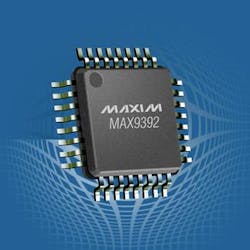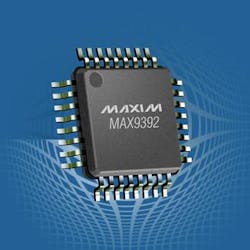Maxim Integrated Products launches dual, 2 x 2 crosspoint switches with "anything-to-LVDS" capability
2 September 2003 Sunnyvale, CA Lightwave -- Maxim Integrated Products recently introduced the MAX9392/MAX9393 dual, high-performance, 2 x 2 LVDS crosspoint switches. The MAX9392 accepts LVDS, HSTL, and other GND-referenced input signals, while the MAX9393 accepts LVPECL, CML, and other Vcc-referenced differential input signals.
Each channel is independently programmed to any input or both outputs, allowing each channel to be configured as a 1:2 splitter, a 2:1 multiplexer, dual repeater, or a 2 x 2 crosspoint switch, explains the company. The LVDS outputs are compatible with the ANSI TIA/EIA-644 LVDS standard. Low random jitter performance (2.0-ps root-mean-square max), low typical output-to-output skew (10 ps), and guaranteed maximum frequency of 1.50 GHz (minimum) make these devices ideal for protection switching in fault-tolerant systems, loopback switching for diagnostics, and fanout buffering for clock/data distribution. Applications include central office switches, networking switches and routers, and SONET/SDH communication equipment.
Although similar to the MAX9390/MAX9391 in features and functions, the MAX9392/MAX9393 has a flowthrough pinout versus a cross-flow pinout for the MAX9390/MAX9391. The operating supply range is 3.3V ± 10%. Both devices are available in 32-pin TQFP and 32-pin thin QFN packages and are specified over the extended temperature range (-40 ° Celsius to +85 ° Celsius).
Prices start at $4.48 and $4.88 in the TQFP and thin QFN packages, respectively in quantities of 1,000 and up.
